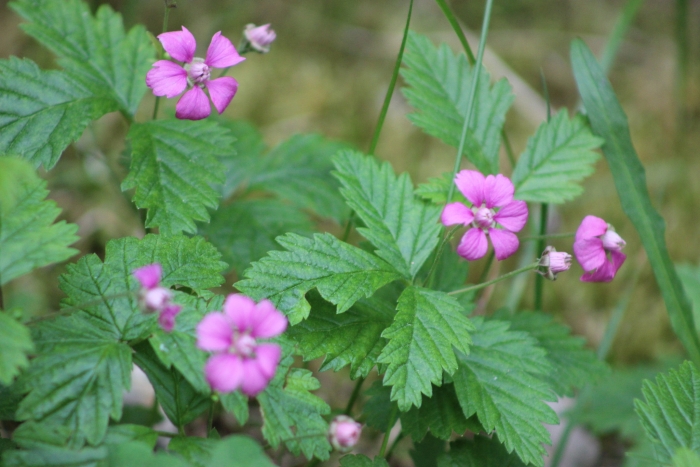Arctic Bramble
(Rubus arcticus)
Arctic Bramble (Rubus arcticus)
/
/

Tatiana Strus
CC BY 4.0
Image By:
Tatiana Strus
Recorded By:
Copyright:
CC BY 4.0
Copyright Notice:
Photo by: Tatiana Strus | License Type: CC BY 4.0 | License URL: http://creativecommons.org/licenses/by/4.0/ | Rights Holder: Tatiana Strus | Publisher: iNaturalist | Date Created: 2018-07-02T10:42:57-07:00 |
























Estimated Native Range
Summary
Rubus arcticus, commonly known as Arctic bramble or Arctic raspberry, is a slowly-growing perennial herb native to circumpolar regions, including arctic and alpine tundra, boreal forests, and peatlands in the Northern Hemisphere, such as Alaska, Scandinavia, Russia, and Canada. It typically grows up to 12 inches (30 cm) tall and spreads through rhizomes, forming low, dense mats. The plant features trifoliate leaves and produces small, pinkish flowers in early summer, followed by deep red or dark purple berries that are both edible and highly prized for their intense flavor.
The Arctic bramble is valued for its fruit, which is used in high-end culinary applications such as jams, liqueurs, and flavoring for tea. Its exceptional hardiness to frost and cold conditions makes it suitable for cultivation in northern climates and rock gardens. It prefers acidic soils rich in organic matter and requires consistent moisture without waterlogging. While it thrives in full sun to partial shade, it can tolerate the low-light conditions of its native subarctic regions. Gardeners appreciate this plant for its ornamental foliage, attractive flowers, and delicious fruit, as well as its ability to attract pollinators. However, it can be susceptible to root rot in poorly drained soils and may require protection from birds and small mammals that also enjoy the fruit.CC BY-SA 4.0
The Arctic bramble is valued for its fruit, which is used in high-end culinary applications such as jams, liqueurs, and flavoring for tea. Its exceptional hardiness to frost and cold conditions makes it suitable for cultivation in northern climates and rock gardens. It prefers acidic soils rich in organic matter and requires consistent moisture without waterlogging. While it thrives in full sun to partial shade, it can tolerate the low-light conditions of its native subarctic regions. Gardeners appreciate this plant for its ornamental foliage, attractive flowers, and delicious fruit, as well as its ability to attract pollinators. However, it can be susceptible to root rot in poorly drained soils and may require protection from birds and small mammals that also enjoy the fruit.CC BY-SA 4.0
Plant Description
- Plant Type: Shrub, Herb
- Height: 0.5-1 feet
- Width: 1-1.5 feet
- Growth Rate: Moderate
- Flower Color: Pink, Red
- Flowering Season: Spring, Summer
- Leaf Retention: Deciduous
Growth Requirements
- Sun: Full Sun, Part Shade
- Water: Medium
- Drainage: Medium
Common Uses
Bee Garden, Butterfly Garden, Edible*Disclaimer: Easyscape's listed plant edibility is for informational use. Always verify the safety and proper identification of any plant before consumption., Low Maintenance
Natural Habitat
Circumpolar regions, including arctic and alpine tundra, boreal forests, and peatlands
Other Names
Common Names: Nagoonberry, Arctic Raspberry, Arctic Blackberry, Bei Xuan Gou Zi, Giedde-Muorje, The Arctic Bramble Or Arctic Raspberry, Vattukat, Vattukka
Scientific Names: , Rubus arcticus, Cylactis arcticus, Rubus arcticus var. arcticus, Rubus arcticus var. grandiflorus, Rubus chamaemorus, Rubus chamaemorus, Rubus chamaemorus,
GBIF Accepted Name: